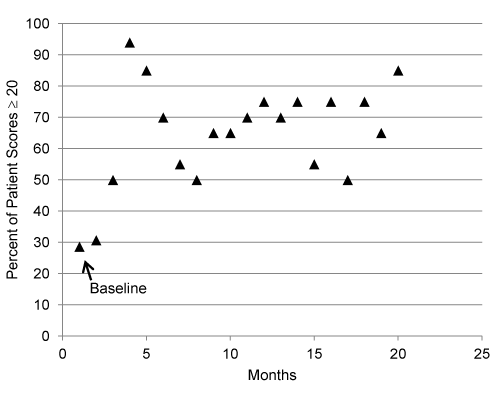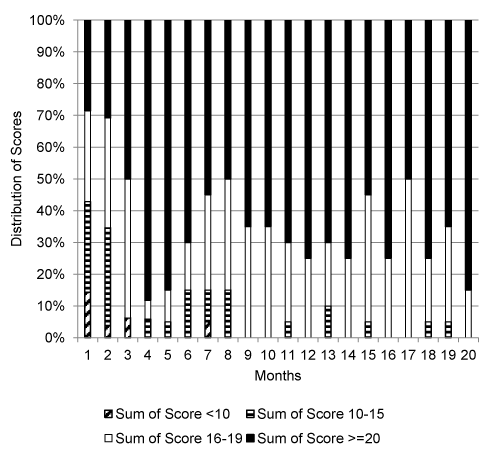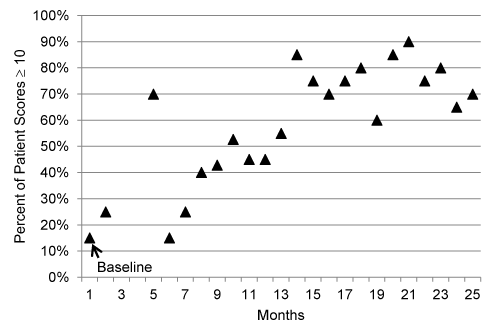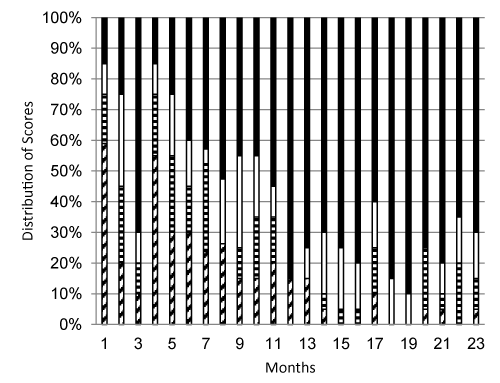International Journal of Diabetes and Clinical Research
Assessment of Learning Guides Improvement in Diabetes Education Program: A QI Initiative for Type I Diabetes Mellitus in Children and Adolescents
Manmohan K. Kamboj1* , Kathryn J. Stephens1, Richard J. Brilli2, Heather L. Yardley3, Jeff Lewis4, Richard E. McClead, Jr.2,3 and David R. Repaske1
1Division of Pediatric Endocrinology, Metabolism, and Diabetes, Nationwide Children's Hospital, Department of Pediatrics, The Ohio State University, USA
2Nationwide Children's Hospital, Department of Pediatrics, The Ohio State University, USA
3Department of Pediatric Psychology and Neuropsychology, Nationwide Children's Hospital, Department of Pediatrics, The Ohio State University, USA
4Quality Improvement Services, Nationwide Children's Hospital, USA
*Corresponding author:
Manmohan K. Kamboj, MD, Nationwide Children's Hospital, 700 Children's Drive Columbus, OH 43205, USA, Tel: 614-722-4425; Fax: 614-722-4440; E-mail: Manmohan.Kamboj@nationwidechildrens.org
Int J Diabetes Clin Res, IJDCR-1-011, (Volume 1, Issue 2), Research Article; ISSN: 2377-3634
Received: October 30, 2014 | Accepted: November 15, 2014 | Published: November 17, 2014
Citation: Kamboj MK, Stephens KJ, Brilli RJ, Yardley HL, Lewis J, et al. (2014) Assessment of Learning Guides Improvement in Diabetes Education Program: A QI Initiative for Type I Diabetes Mellitus in Children and Adolescents. Int J Diabetes Clin Res 1:011. 10.23937/2377-3634/1410011
Copyright: ©2014 Kamboj MK, et al. This is an open-access article distributed under the terms of the Creative Commons Attribution License, which permits unrestricted use, distribution, and reproduction in any medium, provided the original author and source are credited.
Abstract
Aims: To develop objective assessment tools to evaluate proficiency of well-day (WD) and sick-day (SD) diabetes knowledge and management skills in families of pediatric type 1 diabetes patients and to utilize this information to modify our diabetes education (DE) program to improve learning of the desired knowledge and skills.
Methods: Vignette-based assessment quizzes were developed to evaluate WD and SD diabetes knowledge and management skills. Vignettes assessed basic knowledge and skills including calculation of insulin doses, treatment of hypoglycemia, and management of hyperglycemia and ketones. These questionnaires were administered to 20 quasi-random patients and families at routine diabetes clinic visits during a baseline month and every month thereafter. Analysis of baseline data demonstrated significant knowledge deficits, and interventions were implemented to modify our DE curriculum and teaching techniques.
Results: Sustained improvement of WD and SD diabetes knowledge and management skills were demonstrated with passing scores on WD and SD quizzes improving from a baseline of 28% and 15%, respectively, to a sustained pass rate ≥60% on each.
Conclusions: This quality improvement initiative revealed that baseline diabetes knowledge and management skills were less than anticipated. Objective measurement of working knowledge retained by the families, allowed us to assess patient learning and to drive subsequent improvement in our education process. Changes in educational content and approach resulted in sustained improvement. Our work demonstrates a new paradigm in the teaching-learning interaction in the management of diabetes which is likely applicable to other chronic medical conditions.
Keywords
Type 1 diabetes, Quality improvement; Diabetes education, Diabetes management; Adolescents
Introduction
Type 1 diabetes mellitus is a relatively common chronic disease in children and adolescents with a prevalence of approximately 1 in every 400 children in the US [1]. Moreover, the incidence of type I diabetes is rising, especially in younger children [2]. Attainment of optimal diabetes care and metabolic control requires proficiency in knowledge of diabetes and specialized diabetes management skills [3]. Patients and families must learn and retain this knowledge, and apply this learned skill set both for daily “well day” (WD) diabetes management and for relatively rare “sick days” (SD).When diabetic patients are ill whether related to diabetes or not, an additional set of diabetes sick day management skills are required. These skills are necessary to maintain good metabolic control. It is well recognized that poor metabolic control and persistent hyperglycemia on WDs is directly correlated to the development of micro-vascular disease and long term complications of type 1 diabetes [4]. Furthermore, acute hypoglycemia or hyperglycemia with potential ketonemia may develop on SDs and lead to potentially preventable emergency medical visits and/or hospitalizations. Thus, to prevent both long- and short-term complications of type 1diabetes, and to achieve optimal diabetes care and metabolic control, patients and families must acquire sufficient diabetes knowledge and learn effective diabetes management skills.
Comprehensive diabetes education incorporates a structured, standardized educational curriculum and teaching strategies to impart basic and advanced knowledge and skills necessary for diabetes management [5-7]. The educational program should utilize age appropriate patient-centered interactive teaching methods for all care-givers, including the affected child or adolescent [8]. The main learning concepts include a) basic understanding of diabetes and physiology, and b) basic skills needed for well-day (WD) and sick-day (SD) management. The former include blood glucose testing, insulin dose calculations, insulin administration, prevention and management of hypoglycemia. Sick day skills include management of hyperglycemia, ketones, and prevention of short and long term complications. Standardized records of education provided are typically maintained to ensure all items on this extensive agenda are discussed and reviewed at diagnosis of diabetes and at appropriate intervals thereafter. Education of type I diabetes patients is provided by a multidisciplinary team that includes the endocrinologist, diabetes educators, dietitians, social workers, and therapeutic recreation specialist. As learning and retaining diabetes knowledge and skills is a continuous and lifelong process, this team is constantly engaged with patient education from diagnosis onward [9].
Diabetes education programs are effective in increasing diabetes knowledge in the short-term [10,11] However, retention of this knowledge is poor as some skills are used in frequently, there is desensitization to utilization of precise skills, and information taught to parents is not effectively transmitted to children as they grow up [12]. Therefore, as repetition is beneficial, it follows that diabetes knowledge and skills should be assessed throughout the course of the disease [13]. Established, standardized assessment scales of diabetes knowledge and management skills have focused on adults with both type 1 and type 2 diabetes [14,15]. No standardized objective measures are in place to evaluate proficiency of diabetes self-management knowledge and skills in children and adolescents, and their families. As a result, it remains unclear how much education is retained and applied effectively in the child or adolescent with type 1 diabetes and their family. It is reasonable to assume that inadequate proficiency in diabetes knowledge and management skills would negatively impact diabetes management and control. Evaluation and improvement of diabetes education programs and teaching techniques based on patient/family performance and feedback may be particularly important in pediatric diabetes.
With this background, our diabetes quality improvement (QI) team assessed our educational effectiveness. The primary aim was to develop an objective assessment tool to evaluate the proficiency of WD and SD diabetes knowledge and management skills in our children and adolescent patients with type1 diabetes and their families. The second aim was to utilize information obtained from this evaluation to modify our diabetes education program curriculum and teaching methods so as to improve the level of knowledge and proficiency of management in our patients and families with type 1 diabetes. The global aim was to improve diabetes care in our patient population.
Research Design and Methods
This initiative was undertaken as a quality improvement project at Nationwide Children’s Hospital (NCH). All subjects participated voluntarily. A multidisciplinary diabetes QI team comprised of endocrinology physicians and advanced practitioners, certified diabetes educators, registered dieticians, registration, data coordinator, psychologist, and social workers. This group designed two separate vignette-based quizzes to assess WD and SD knowledge and management skills (Supplemental Material). These quizzes were based on standard information included in our educational curriculum and were modeled after real-life, problem-solving scenarios that children and families face at home including calculation of insulin doses, treatment of hypoglycemia, and management of hyperglycemia and ketones. The quizzes were administered to a convenience sample of 20 families of children and adolescents with type 1 diabetes selected quazi-randomly at routine diabetes clinic visits during a baseline month and monthly thereafter. Quizzes were administered by personnel not directly involved in diabetes education. For consistency, each quiz type was scored by the same person. Based on a minimum level of proficiency needed to adequately manage diabetes, a passing score on the well-day knowledge and management skills quiz was set at ≥ 20/25 correct answers. A passing score for the sick-day knowledge and management skills quiz was set at ≥ 10/15 correct answers. Modifications or clarifications in both the WD and the SD quizzes were made based on patient and provider feed-back, without changing the content of the questions. We noted that many patients and families were not willing to spend the extra time after their visit to complete the quiz, and some rushed through it leaving it incomplete. To achieve greater interest and compliance, an incentive was introduced - a free parking token was given to patients and families for completion of the quiz. This small change in process greatly improved patient/family enthusiasm to complete the quizzes with attention to detail, making it easier for clinic staff to obtain the required number of completed quizzes per month.
After assessment of baseline data, interventions were designed and implemented to improve in-clinic diabetes education and to modify teaching techniques. Analysis of incorrect quiz responses informed discussions by team members on how to improve patient/family learning. Quiz results indicated that families had varying and diverse knowledge gaps. These knowledge gaps included: insulin dosing parameters, confusion over common diabetes terminology (carbohydrate ratio, correction factor/sensitivity, hyperglycemia correction target and glucose target range), the lack of awareness that extra insulin is required when ill and ketonemic, knowing the allowable frequency in insulin dosing for carbohydrate and for hyperglycemia correction, and appropriate treatment of hypoglycemia. The team used the principles of The Improvement Guide [16] including fishbone analysis to develop key driver diagrams (see Supplemental Material) to focus discussion and guide initial improvements. Monthly quiz results were displayed on run charts to assess the impact of interventions over time. PDSA cycles were utilized to guide improvement.
The interventions targeted to improve diabetes education were multifaceted. They were aimed at addressing both the educational content and the individualized teaching methods. Initial interventions to modify the diabetes education curriculum for patients and families included specific focus on challenging aspects of well-day skills and sick-day management of diabetes. Interventions to modify teaching techniques included individualization of teaching based on learning style with reiteration of important concepts by verbal and written recall. “Real-life” problem-solving scenarios and vignettes were introduced to highlight specific key concepts and principles. An insulin bolus dose calculator guide sheet was utilized to practice insulin dose calculations. Direct demonstration of proficiency immediately post-teaching was assessed by appropriate questions, and the concept was revisited immediately if there was a deficiency identified. These teaching interventions were implemented during a 30 minute session allocated to diabetes education at every other diabetes follow-up clinic visit, every 6 months. Deliberate effort and emphasis was made towards establishing consistency in the content taught by different providers thus avoiding ‘mixed messages’ and conflicting information. During the education session, at least 5-10 minutes was allocated to specifically review SD management using the SD algorithm, called SOS, a whimsical nomenclature referencing a need for help, that incorporates a detailed stepwise pathway of management of diabetes during illness (see Supplemental Materials). We began an aggressive campaign to distribute the SOS to patients and families at each visit if they did not have one with them or at home. It was also mailed to each patient’s home, and posted on our institution’s web site for easy access. Run charts were utilized to monitor the possession of the SOS sheet. At the clinic visit, we first ensured that every family was aware of the SOS guidelines. Its use was reviewed specifically emphasizing insulin dosing parameters for hyperglycemia and ketones, recommendations for frequent monitoring of blood glucose, and maintaining hydration when sick.
In response to uncertainty in some patients as to their diabetes management including insulin regimen, testing regimen, follow-up recommendations, and when and how to contact the Diabetes Center the QI team evaluated the after-visit summary (AVS)is given to each family at the conclusion of each clinic visit. Further evaluation revealed that the document from different providers had significantly different content. The QI team standardized the essential information for optimal management of diabetes between clinic visits and incorporated this information in an electronic template in the patient’s medical record. The AVS included: current hemoglobin A1C; complete current insulin regimen and any recommendations for dose changes; documentation of total daily basal insulin and supplemental insulin dosing for ketone correction per SOS; recommendations for annual blood work as needed; recommendations for testing. In addition the AVS provided the plan for clinic follow up and contact numbers to facilitate communication between families and staff between clinic visits. Run charts were used to audit and monitor the completeness of essential components of each provider’s AVS.
Results
SOS possession
At baseline, only 25% of patients and families in our diabetes clinic audited at random (20 patients) stated that they possessed a copy of SOS guidelines. Following our aggressive distribution campaign, 100% of our patients and families audited at random had SOS guidelines in their possession. This has been consistently held at 100% thereafter (Supplemental Material).
AVS
Our initial audit revealed that 100% of our families were given an AVS. However, the baseline audit revealed that 0% of the distributed AVS had all the essential components. With the implementation of the standardized AVS template and monthly provider feedback there was continuous improvement over one year until consistently 85% of audited AVS contained all of these essential elements (Supplemental Material).
Well-day (WD) knowledge and management skills
At baseline, 28% of patients and families achieved the desired passing score of ≥ 20/25 correct answers on the WD diabetes knowledge and management skills quiz. Following educational interventions, a gradual and sustained increase in passing scores has been maintained (Figure 1). Overall score distribution changed over time with increasing numbers of patients in the higher score categories (Figure 2).

Figure 1: Run-chart of well-day test scores over time. The first month was
baseline before interventions were initiated. Subsequent monthly scores
demonstrate improvement as the result of interventions described in the text.
View Figure 1

Figure 2: Stacked bar chart of well-day test scores over time. This
representation of the data demonstrates improvement in the test scores even
for those who did not achieve a passing score.
Sick-day (SD) knowledge and management skills
At baseline, 15% of patients and families achieved the desired passing score of ≥10/15correct answers on the SD knowledge and skills quiz. After interventions, including dedication of 5-10 minutes at every other clinic visit to SOS teaching, there was a steady and sustained increase in the number of patients achieving the desired score to a maximum of 90% (Figure 3). In month 3of this initiative, an unexpected increase in the pass rate occurred (70% of patients passed). This was due to a protocol violation resulting from quizzes not being administered at random, but instead distributed to families immediately following an intensive sick-day teaching session. This data was included in the overall analysis because it demonstrated that given the opportunity and time, patients and families can learn and demonstrate immediate post-education recall! Over the course of this initiative, analysis of distribution of scores reveal a greater number of patients achieving higher scores, thus signifying overall level of improvement in most patients (Figure 4).

Figure 3: Run-chart of sick-day scores over time. The first month was baseline
before interventions were initiated. Subsequent monthly scores demonstrate
improvement as the result of interventions described in the text.
View Figure 3

Figure 4: Stacked bar chart of sick-day scores over time. This representation
of the data demonstrates improvement in the test scores even for those who
did not achieve a passing score.
View Figure 4
Conclusions
A baseline audit revealed that only 25% of families possessed the SOS. Since this algorithm is utilized only when patients are sick, these skills may be easily forgotten. Therefore, it is a reasonable assumption that patients and families would not be able to follow a sick-day algorithm and demonstrate appropriate sick-day management skills if they did not have an SOS available to them.
This quality improvement initiative demonstrates that proficiency of well-day and sick-day diabetes knowledge and management skills in our patients with type1 diabetes and their families was suboptimal at baseline. It clearly demonstrated that our assumption that the educational material that was taught was being retained in a useful manner was incorrect. It shows that objective measures are essential to evaluate the amount of patient education that is actually retained and used.
The evaluation of baseline quiz results and the monthly reassessments by our QI team allowed for ongoing identification of deficiencies in the teaching-learning interaction. This was instrumental for fine-tuning our diabetes education curriculum, and improving our teaching techniques and methodologies. Regular discussions with the multidisciplinary diabetes QI team and reporting of our positive results to the other staff helped to keep up the momentum of improvement. Since implementation of this quality improvement initiative, we have assessed well-day and sick-day knowledge and management skills in nearly half of our patients and families and feel that this has improved the overall awareness of appropriate diabetes management and the importance of the overall education process. Initial concerns of our staff for possible punitive implications for poor performance on quiz scores required some reassurance. It was repeatedly emphasized that the quiz scores were reflective of our patient’s level of learning resulting from our educational program design, rather than the quality of individual education provided, and the aim was to identify concerns to drive program improvements.
Our work suggests the need for a paradigm shift in the medical provider-patient interaction to better serve the educational needs of patients with type 1diabetes. Simply utilizing a multi-disciplinary team to ensure that basic diabetes information and daily living skills are taught may not be enough to impart proficiency of this knowledge and skill set. Objective evaluation and ongoing assessment of our own diabetes education program was essential in order to drive change and improve retention of patient knowledge and skills. Novel objective assessment tools may need to be developed by institutions if none exist, as is demonstrated by our group. Furthermore, we found teaching techniques utilizing a patient-centered problem-solving approach to education enabled patients and families to become active participants in their management. Finally, we demonstrated that process measures may not need to be complex. Simple measures may result in significant improvement.
We are currently extending the concept of learning assessment to new-onset type 1 diabetes education in order to further improve diabetes education and modify teaching techniques. A “new-onset diabetes” quiz was instituted prior to hospital discharge to assess patient’s and families’ level of proficiency with very basic diabetes skills after initial education. This has enabled educators to identify and address major deficiencies in basic diabetes management skills prior to discharge. We have also initiated a similar tool for blood glucose pattern recognition and management education as well. We are hopeful that these QI initiatives will continue to drive improvement in diabetes care of our patients. These data reflect significant improvement in the knowledge of our patients and over time this may result in improved outcomes for patients with diabetes mellitus including fewer hospital admissions, fewer acute care visits, decrease in school absences, improvement in glycemic control with decreased hemoglobin A1c levels, and decrease in short and long term complications.
The objective results of our diabetes knowledge and management skills quizzes aided our group in modifying and improving our existing approach to diabetes education. It may be anticipated that with such robust improvements in diabetes knowledge and management skills, diabetes care and metabolic control may show improvement resulting in improved health outcomes and subsequent decreased health care costs. The lessons learned here are clearly not limited to type 1 diabetes or pediatrics. Most chronic illnesses are dependent on self-management for optimal care. We see great potential for the use of this concept in almost all medical and pediatric specialties, and especially in the care of other chronic diseases
Acknowledgements
The authors thank the patients for their participation in completing the questionnaires and the Diabetes Center QI team members for their contributions to development and implementation of this project.
References
-
(2011) Total Prevalence of Diabetes. [http://www.diabetes.org/diabetesbasics/diabetes-statistics/]
-
Patterson CC, Dahlquist GG, Gyürüs E, Green A, Soltész G; EURODIAB Study Group (2009) Incidence trends for childhood type 1 diabetes in Europe during 1989-2003 and predicted new cases 2005-20: a multicentre prospective registration study. Lancet 373: 2027-2033.
-
Brink SJ1, Miller M, Moltz KC (2002) Education and multidisciplinary team care concepts for pediatric and adolescent diabetes mellitus. J Pediatr Endocrinol Metab 15: 1113-1130.
-
(1993) The effect of intensive treatment of diabetes on the development and progression of long-term complications in insulin-dependent diabetes mellitus. The Diabetes Control and Complications Trial Research Group. N Engl J Med 329: 977-986.
-
Mensing C, Boucher J, Cypress M, Weinger K, Mulcahy K, et al. (2000) National standards for diabetes self-management education. Task Force to Review and Revise the National Standards for Diabetes Self-Management Education Programs. Diabetes care 23: 682-689.
-
Silverstein J, Klingensmith G, Copeland K, Plotnick L, Kaufman F, et al. (2005) Care of children and adolescents with type 1 diabetes: a statement of the American Diabetes Association. Diabetes Care 28: 186-212.
-
Swift PG (2009) Diabetes education in children and adolescents. Pediatr Diabetes 10 Suppl 12: 51-57.
-
Kienle GS, Meusers M, Quecke B, Hilgard D (2013) Patient-centered Diabetes Care in Children: An Integrated, Individualized, Systems-oriented, and Multidisciplinary Approach. Glob Adv Health Med 2: 12-19.
-
Brink SJ, Chiarelli FG (2004) Education and multidisciplinary team approach in childhood diabetes. Acta Biomed 75: 7-21.
-
Lucey D, Wing E (1985) A clinic based educational programme for children with diabetes. Diabet Med 2: 292-295.
-
Verrotti A, Chiarelli F, Sabatino G, Blasetti A, Tumini S, et al. (1993) Education, knowledge and metabolic control in children with type 1 diabetes. Riv Eur Sci Med Framacol 15: 5-10.
-
Hackett AF, Court S, Matthews JN, McCowen C, Parkin JM (1989) Do education groups help diabetics and their parents? Arch Dis Child 64: 997-1003.
-
Nakatani Y, Matsumura M, Monden T, Aso Y, Nakamoto T (2013) Improvement of glycemic control by re-education in insulin injection technique in patients with diabetes mellitus. Adv Ther 30: 897-906.
-
Dunn SM, Bryson JM, Hoskins PL, Alford JB, Handelsman DJ, et al. (1984) Development of the diabetes knowledge (DKN) scales: forms DKNA, DKNB, and DKNC. Diabetes Care 7: 36-41.
-
Fitzgerald JT, Funnell MM, Hess GE, Barr PA, Anderson RM, et al. (1998) The reliability and validity of a brief diabetes knowledge test. Diabetes Care 21: 706-710.
-
Langley GJ (2009) The improvement guide: a practical approach to enhancing organizational performance. San Francisco, Jossey-Bass.





